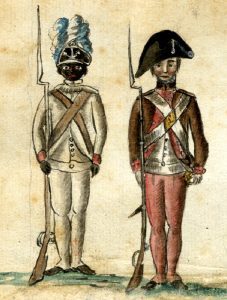The Revolutionary War Soldier’s Load: Profiles of an Army

American Soldiers at Yorktown in 1781 as depicted by Jean-Baptiste-Antoine deVerger. Brown University.
How to register:
We offer two field trip scheduling options:
- Select a field trip from the Museum’s public event schedule
- Request to schedule a field trip time that meets your group’s schedule
Audience:
All audiences. Content appropriate for Grades 6-12.
Goal:
Learn how the Continental Army, through the lens of three individuals, united around a common cause during the Revolutionary War.
Program Description:
Over 200,000 Americans served in the Continental Army during the Revolutionary War. These diverse individuals came together to eventually form a functioning and professional Army. Join us to explore how American patriots worked together to create the Continental Army by examining the uniforms, equipment, and weapons of Revolutionary War Soldiers.
Objective: At the end of the lesson, students will be better able to:
- Identify uniforms, weapons, and equipment used by Revolutionary War Soldiers and describe their functions.
- Describe how Soldiers using the objects carried out the Continental Army’s mission
- Summarize how Soldiers endured hardships and overcame challenges.
- List examples of non-traditional social groups that contributed to the creation of the Continental Army and ultimately American independence.
Guiding Questions:
What are the origins of the United States Army?
How did the items that Soldiers carried during the Revolutionary War help carry out the Continental Army’s mission?
Curriculum Connections
Common Core Standards
- CCSS.ELA-LITERACY.RH.6-8.2
Determine the central ideas or information of a primary or secondary source; provide an accurate summary of the source distinct from prior knowledge or opinions.
Hisory and Social Science Standards of Learning for Virginia Public Schools
- United States History to 1865
- USI.6 The student will apply history and social science skills to explain the American Revolution by
- A) identifying the causes and effects of the French and Indian War;
- B) identifying the issues of dissatisfaction that led to the American Revolution, including, but not limited to the “injuries and usurpations” outlined in the Declaration of Independence;
- D) describing the leadership roles of individuals, including, but not limited to George Washington, Benjamin Franklin, Thomas Jefferson, Patrick Henry, Thomas Paine, John Adams, and the Marquis de Lafayette;
- E) examining the causes, course, and consequences of key events and battles of the era.
- USI.6 The student will apply history and social science skills to explain the American Revolution by
- Virginia and United States History
- VUS.5 The student will apply history and social science skills to understand the issues and events leading to and during the revolutionary period by
- a) describing the results of the French and Indian War;
- c) describing efforts by individuals and groups to mobilize support for the American Revolution, including the Minutemen, the Sons of Liberty, the First and Second Continental Congresses, and the Committees of Correspondence;
- e) analyzing the intervention of France and other factors that led to colonial victory in the Revolutionary War;
- VUS.5 The student will apply history and social science skills to understand the issues and events leading to and during the revolutionary period by
Your message has been submitted.
